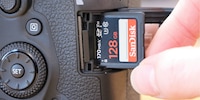
Guide
Buying advice: Suitable memory cards for smartphone, camera or drone
by Jan Johannsen

Memory cards come in many varieties. I tried out the Sandisk Extreme Pro SDCX U3 to find out why and why it is worth paying attention to speed.
The "U3" in the name of the Sandisk Extreme Pro SDCX U3 stands for a guaranteed minimum write speed of 30 MB/s. Sandisk even offers up to 90 MB/s and a read speed of up to 170 MB/s for its card - in contrast to the significantly more expensive Extreme Pro SDXC UHS-II, which is said to achieve up to 300 MB/s.
Our buying guide provides you with a general overview of memory cards, which also explains the technical differences between SDHC and SDXC.
This sounds promising and I tried to test it out with the EOS 90D. The SLR camera takes photos and videos in UHD quality. A half-hour UHD recording was no challenge for the memory card.
To find out whether the memory card fulfils the advertised read and write speeds, I used the Atto Disk Benchmark. This measures the read and write performance of transfer sizes between 512 bytes and 64 megabytes. For the Extreme Pro SDXC U3, it determines a write speed of 85 MB/s and a read speed of 93 MB/s for a 24 megabyte file - roughly equivalent to a photo in RAW format. The write speed thus comes very close to the 90 MB/s promised by Sandisk. The read speed, on the other hand, is still well short of the advertised maximum of 170 MB/s.
In practice, this means that the Extreme Pro takes 3:54 minutes to copy the 21.84 gigabyte UHD video file. This corresponds to the measured read speed of 93 MB/s. And I had already feared that the card reader in my older MacBook Pro would be a bottleneck.
My personal SLR camera is a bit older and doesn't have a slot for an SD card. Instead, I use a CF card with 16 gigabytes of storage space. That's more than enough for private photos from my holiday. However, UHD videos are not possible with this memory card. The Atto Disk Benchmark determines a write speed of 21 MB/s and a read speed of 34 MB/s for the CF card. This is significantly less than the Sandisk Extreme Pro.
And another example: I found an SDHC card in my desk drawer that I used to use in a compact camera. It's also from Sandisk and is a good example of the difference in speed between an SDHC and an SDXC card: the Atto Disk Benchmark measures a write speed of 5 MB/s and a read speed of 23 MB/s. That used to be enough for photos. This used to be easily enough for photos, but today it already leads to waiting times when saving.
In other words: If you want to buy a new SD card, go for an SDXC card. Even if the capacity is significantly larger than you might need: The read and write speeds are significantly better.
The Sandisk Extreme Pro SDCX U3 falls far short of the maximum write speed advertised by the manufacturer, but is still fast enough for private use. Even for photo and video transfer in the editorial team, the speed is sufficient for me. Only as a professional photographer or videographer who has to copy huge amounts of data would I perhaps spend more money on an even faster memory card.
When I was but a young student, I'd sit in my friend's living room with all my classmates and play on his SuperNES. Since then I've had the opportunity to test out all the newest technology for you. I've done reviews at Curved, Computer Bild and Netzwelt, and have now arrived at Galaxus.de.